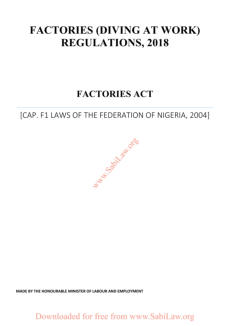Diving & ROV Procedures 1960 - 2018

The US Navy Emergency Ship Salvage Material System is a
combination of bases and complexes that provide ship
salvage, pollution control, and underwater ship
husbandry equipment on an emergency basis.
This document, published in 1999, and released to all
public since 2006, is a catalog of the various salvage
equipment available.
Contractors can use it to decide on relevant equipment
for ship salvages. However, the solutions it proposes are
suitable for many construction activities, and for this
reason, this document should not be considered for
salvage operations only.


The "Defense and Civil Institute of Environmental
Medicine" (DCIEM) published these diving tables, which
were derived from the DCIEM 1983 decompression
model, in 1992. Note that the institute no more develops
them. Nevertheless, they remain one of the best
decompression models that can be used with the COMEX
MT 92.
DCIEM has been reorganized in April 2000 and is now
"Defense Research and Development Canada" (DRDC)
These tables can be downloaded by clicking on the
picture of the cover.

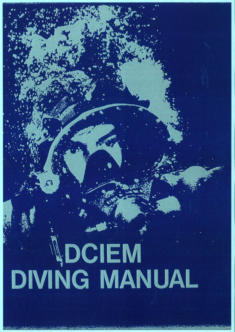

NORSOK (Norsk Sokkels Konkuranseposisjon - Norway) is
an organization created by the Norwegian petroleum
industry that emits specifications and recommendations.
Among the documents published by this organization,
NORSOK standards U100 and U101 that discuss diving
procedures and equipment are
mandatory in Norwegian waters and commonly
implemented in other locations.
These publications are sold through specialized
organizations and can be paid and downloaded by
clicking on the picture of the cover on the side.

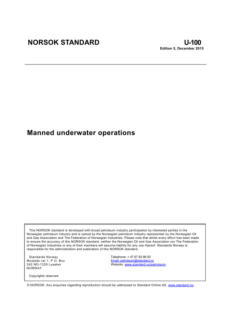


This training code of practice is intended to assist the
following, amongst others:
• Approved and prospective training
establishments
• Personnel involved in commercial diver training
• Personnel involved in Quality Assurance and
Safety
• Department of Labour Inspectors
• All personnel involved in Quality Assurance,
Health and Safety.


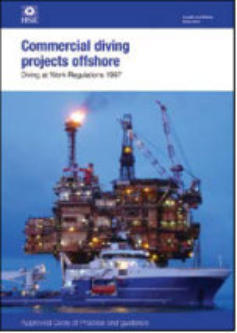


The French Ministry of labor published this table for coral
fishing divers in response to the numerous accidents that
have happened due to the fact that these people were
using air at depths up to 90 m, and sometimes more.
This table can be downloaded by clicking on the picture
of the cover.


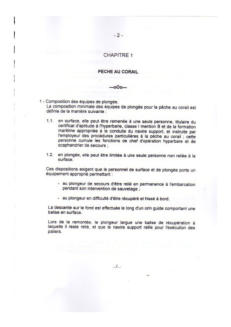


This manual is the evolution of the previous versions
published in public releases that are available in the folder
“Historical diving”.
It can be downloaded by clicking on the picture of the
cover.


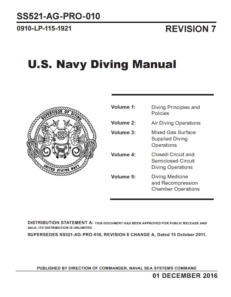

The Dutch governmenthas introduced a new system of
accredditation and certification, based on International
NEN EN ISO 17021 (system) and 17024 (person) norms.


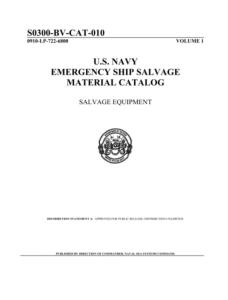

The US Navy Emergency Ship Salvage Material System is a
combination of bases and complexes that provide ship
salvage, pollution control, and underwater ship
husbandry equipment on an emergency basis.
This document, published in 1999, and released to all
public since 2006, is a catalog of the various pollution
equipment available.
Contractors can use it to decide on relevant techniques
for oil spills and other pollutions in harbors and offshore.

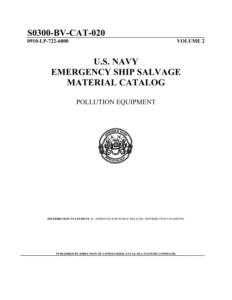

The US Navy says that this manual, published in 1989 and
updated in 2002, is intended to provide information on
the use of conventional techniques for cutting and
welding metals underwater. It is written for the U.S. Navy
divers who specialize in ship salvage and harbor clearance
operations. It is not a procedural guide for certifiable
welding used in pre-planned underwater ship husbandry
applications.
Note that IOGP and IMCA exo-cutting procedures are
based on those indicated in this document.

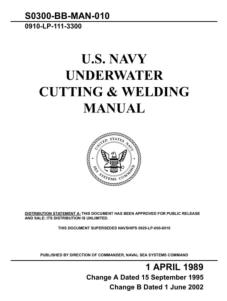

The US Navy says that ship salvors must have a firm grasp
of the principles of naval architecture to understand how
vessels will react to salvage techniques applied to
safeguard personnel and equipment.
This document, 1st published in 1989, and updated in
2006 and 2013, provides the basic foundation of naval
architecture and its application to marine salvage.
As for the documents above, the guidelines it provides
can be used for other works than ship salvage.


Air transfer may be necessary for medical or logistical
reasons to evacuate a person suffering from a
decompression accident.
In such a case, an emergency evacuation hyperbaric
stretcher that maintains the patient at the sea level
pressure (1.013 bar) can be used to compensate for the
depression in the aircraft cabin.
This US Navy document describes the design and
maintenance of such equipment.

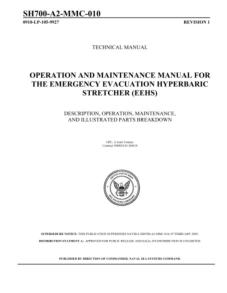

EDTC stands for “European Diving Technology
Committee”. The aim of the EDTC is to make European
professional diving safer.
In 2017 the EDTC carried out a comparison of diving
regulations in countries across geographic Europe. This
highlighted the need to establish an umbrella document
to be followed by any countries that might find guidance
from the document and for those that have little or no
regulation.


Gas analysis and monitoring are required to establish and
maintain an acceptable atmosphere during diving
operations.
This manual. published in 2005, provides guidance and
explanations regarding cleaning requirements,
determination of gas analysis requirements, and the
maintenance of the gas analysis equipment.variables.

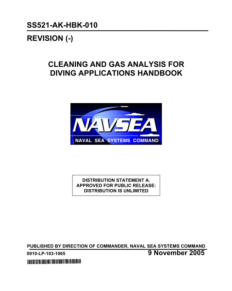

Authors: M. Stipanov, V. Bakaric, Z. Eškinja
This paper describes a cave mapping and modeling
method using an ROV equipped with a scanning sonar,
depth sensor, and an electronic compass. The technique
described was thought of and operated by Brodarski
Institute LLC for mapping and modeling the “Vilina spilja”
cave, located near Petrovac in Montenegro. The result
was a 3D digital model of the explored part of the cave,
which was used for more accurate volume and water
inflow estimation.

Authors:
Peter F. Straub, Steven Evert, Tara L. Harmer Luke, & Mark
C. Sullivan.
The goal of this project was to survey and map artificial
reef habitats to evaluate reef functions. Surveys and
mapping were undertaken using digital side-scan sonar
and a remotely operated vehicle (ROV) with sonar and
video capability.
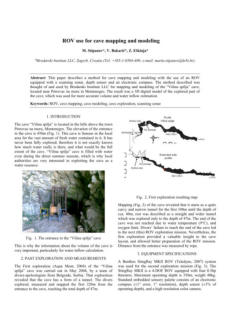


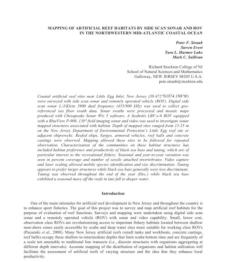

Authors: M. Caccia, G. Bruzzone, G. Veruggio
The problem of high-precision bottom-following in the
proximity of the seabed for open-frame uncrewed
underwater vehicles (UUVs) is addressed in this paper.
The suggested approach consists of the integration of a
guidance and control system with an active multi-
hypothesis extended Kalman " filter, able to estimate the
vehicle's motion with respect to the bottom profile.

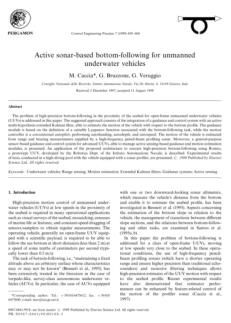


Year of publication: 2017
Author: Francis Hermans
This document discusses the results of a safety survey
organized to find out how divers perform or have
performed underwater oxy-arc cutting operations.
Francis Hermans has also written the following
documents on the same topic:
1.
Influence of oxygen purity in underwater cutting.
2.
Explosiveness of the underwater residual cutting
gasses Part 1: Fresh water
3.
Underwater Cutting Explosions Causes / Effects /
Consequences & Prevention


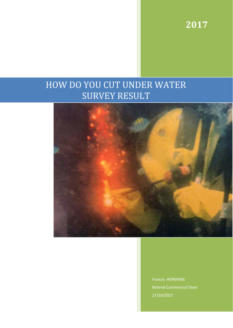

Author: Paul E O’Connor
The purposes of this guide are to provide information on
the nontechnical skills required for safe and productive
operations by U.S. Navy dive teams. Nontechnical skills are
required for safe and effective performance in a technical
context but are not directly related to technical expertise.
The nontechnical skills addressed in this guide include
situation awareness, decision making, team
working/leadership, and mitigating the effects of stress
and fatigue. Communication is not included as a separate
topic since it underpins every one of these skills.
Reference USN: NEDU TR 05-09
Date: June 2005

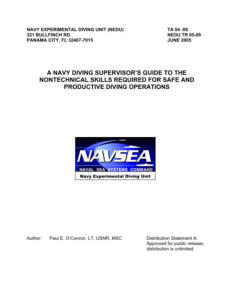

Authors: J. Łabanowski, D. Fydrych, G. Rogalski
This paper from the Department of Materials Technology
and Welding at Gdansk University of Technology (GUT),
published in 2008, describes the principles of underwater
welding and trends in research works undertaken for
enhancing these technologies and the properties of
underwater welds
Document provided by Francis Hermans.

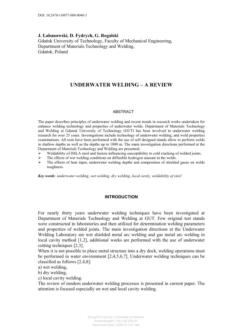

Authors:
Terence M. Browne, Thomas J. Collins, Michael J. Garlich,
John E. O’Leary, Daniel G. Stromberg, Katherine C.
Heringhaus
This manual, disseminated under the sponsorship of the
United States Department of Transportation, aims to
provide guidelines for underwater bridge inspection,
acquaint those responsible for bridge safety with
underwater inspection techniques and equipment, and
present commonly found defects. It should interest bridge
and maintenance engineers, divers, and inspectors.
Document provided by Francis Hermans



Authors:
Terence M. Browne, Thomas J. Collins, Michael J. Garlich,
John E. O’Leary, Daniel G. Stromberg, Katherine C.
Heringhaus
This manual, disseminated under the sponsorship of the
United States Department of Transportation, is intended to
serve as a reference for design engineers, construction
inspectors, resident engineers, inspection divers, and other
administrative and technical staff whose work tasks
include the repair or rehabilitation of elements of bridges
or similar structures located below water.
Document provided by Francis Hermans

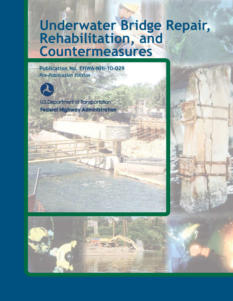

Publisher:
Geneva International Centre for Humanitarian Demining
(GICHD)
This guide provides relevant policies and practices for the
survey and clearance of underwater explosive ordnance.
Specific cases are used; they provide examples and
analysis. It is not intended to be a comprehensive
database of policies and practices; it provides national
authorities and mine action organisations with guidance
to better understand the issues and complexities of
underwater EO survey and clearance operations.
Document provided by Francis Hermans.

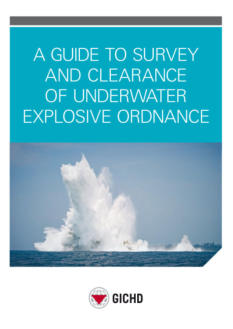

Author: The Clean Water Team Guidance Compendium
for Watershed Monitoring and Assessment State Water
Resources Control Board - USA
This small article can be used in complement of
documents such as the book #4 “diving accidents” of our
“saturation diving handbook”, or IMCA D 045

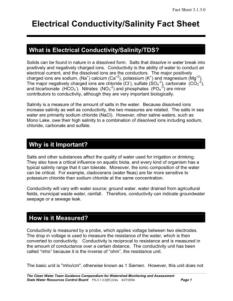
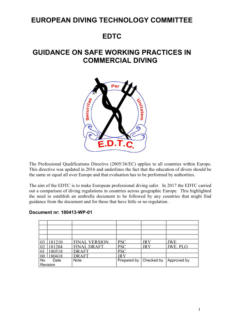

Regulations for health and safety at work issued by the
German Employers’ Liability Insurance Association


Danish act on diving operations and diving equipment,
etc., of 20 July 2010 with the amendments deriving from
section 62 of act no. 1231 of 18 December 2012 and
section 2 of act no. 618 of 12 June 2013


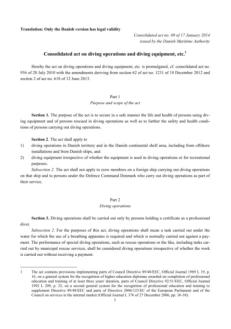


These guidelines consist of five documents that came in
force in 2014:
1 - Commercial diving projects offshore.
2 - Commercial diving projects inland/inshore.
3 - Recreational diving projects.
4 - Media diving projects.
5 - Scientific and Archaeological diving projects.
They can be downloaded by clicking on the picture of the
cover, or at this address:
https://www.hse.gov.uk/diving/acop.htm
Note:
Clicking on the titles above allows opening each document.


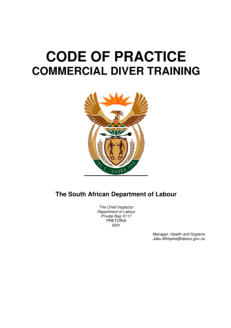
This inland/inshore Code of Practice is intended to assist
the following, amongst others:
• Personnel involved in inshore diving operations
• Client’s staff involved in the preparation of bid
documents and contracts
• Client and Contractor Representatives
• Vessel owners and marine crews involved with
diving operations
• Various Installations and Managers using divers.
• Personnel involved in Quality Assurance and
Safety.




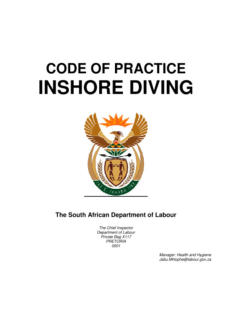
This document is intended to assist the following, among
others:
• Personnel involved in Scientific diving operations.
• Client’s staff involved in the preparation of bid
documents and contracts.
• Client and Contractor Representatives.
• Vessel owners and marine crews involved with
diving operations.
• All personnel involved in Quality Assurance and
Safety.
• All personnel involved in the planning and
execution of Scientific diving projects.



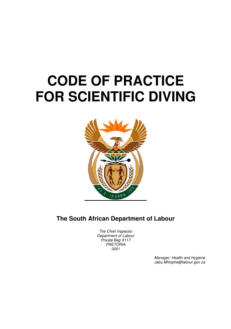

The German version of this guideline was developed
under the leadership of DNV GL SE and with the support
of the German federal ministry for economic affairs and
energy (BMWI) by the working group “Offshore diving” in
order to achieve uniform minimum standards for diving in
German coastal waters and German exclusive economic
zone (EEZ).
The translation and preparation of the English version of
this guideline was solely sponsored by DNV GL SE.

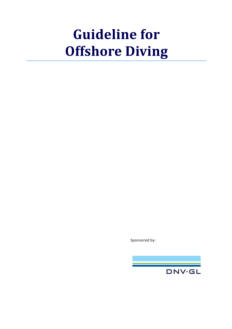


These regulations may be cited as the Irish Safety, Health,
and Welfare at Work (Diving) Regulations 2018, which
came into operation on 1 May 2019.


Authors: Robert D. Christ & Robert L. Wernli
This manual, which is today published free of charge on
the internet, can be considered a reference ROV
pilots and technicians should read.

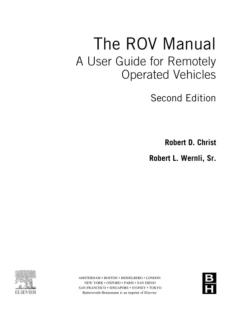
The WHO Guide to ship sanitation has become the official
WHO global reference on health requirements for ship
construction and operation. This document could have
been classified into another topic. However, we have
considered that the sanitary condition of a vessel is of
primary importance and must be taken into account
when preparing a project.


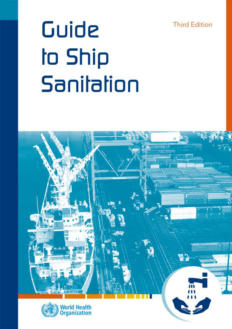

These UPTD tables are those calculated by doctor Wright
in 1972 and discussed in the chapter “Adverse effects of
hyperbaric oxygen” of book #1 of our surface-supplied
diving handbook.
The UPTD system is still used by many diving
organizations, even though scientists consider that it is not
as accurate as thought initially and work to replace it with
a more modern system.

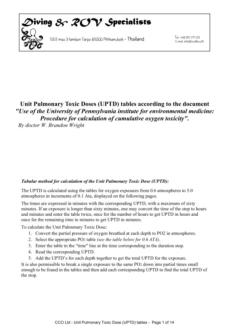

This document replaces the previous version of MA1
published in
December 2011, following a review by the Health and
Safety Executive
(HSE). In undertaking the review, HSE collaborated with
the UK Sports Diving Medical Committee and received
contributions from invited experts on the following
sections of MA1: obesity, mental health, respiratory fitness,
cardiovascular fitness, neurological fitness, ENT, diabetes
and exercise testing.

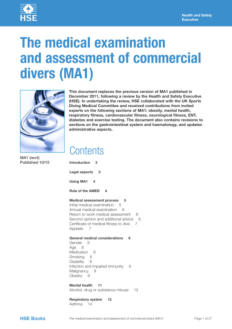

This document from the ROV committee of the Marine
Technology Society (MTS), has been produced to provide
guidance and information to those who use, plan to use,
or are just interested in unmanned underwater systems
and their associated technology. For this reason, it is not
presented as a set of standards, but as a compendium of
information relating to the status of unmanned undersea
vehicles around the world. Any discussions or descriptions
of systems, subsystems and their operation are provided as
guidelines for those working or interested in the field of
unmanned underwater vehicles.
Click on the text download from MTS website




This guide looks at the Work in Compressed Air
Regulations 1996 and addresses such issues as safe
systems of work, medical surveillance, compression and
decompression procedures, medical treatment,
emergency procedures, fire precautions and instructions
and training.

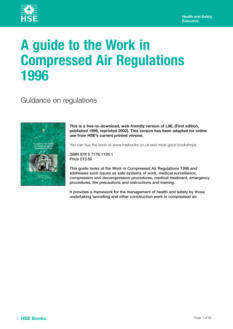





Author: David Smart
The Australian Diver Accreditation Scheme (ADAS) had its
genesis in the 1990s in response to a need to produce
occupational divers who were trained to international
standards with the necessary skills to safely undertake
complex work in high-risk environments. Well-trained dive
teams who are ‘fit-for-purpose’ can be regarded as the
highest level of risk control in preventing accidents and
workplace morbidity. Without such training, work site
risks are not detected, with potentially disastrous
consequences.

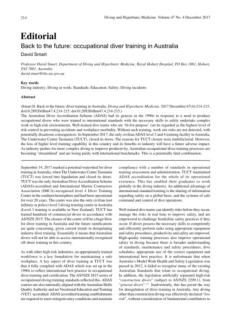

The “Atlas of Pilot Charts” is an essential source of
information for those involved in diving and ROV
operations to evaluate the more favorable periods and
those to avoid in a particular area. It consists of five books
that depict the prevailing weather patterns, including
wind directions and speeds, wave heights, ocean currents,
visibility, barometric pressures, sea surface temperatures,
percentage possibilities for winds of Force 8 or greater,
and ice limits to be found in the areas covered for each
month of the year.
Click on the pictures or the titles below to open the
corresponding documents.
•
Atlas of pilot charts Indian Ocean (2001)
•
Atlas of pilot charts North Pacific Ocean (1994)
•
Atlas of pilot charts South Pacific Ocean (1998)
•
Atlas of pilot charts North Atlantic Ocean (2002)
•
Atlas of pilot charts south Atlantic Ocean (1995)

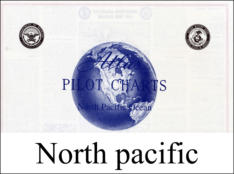

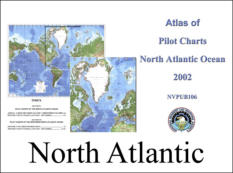
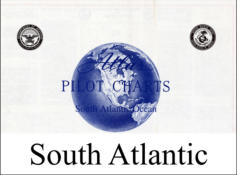

Publisher: Marine transfer forum
This document provides guidelines to ensure that
personnel transfers by crane are conducted safely,
whether for routine crew changes or operational reasons.
It also highlights the critical role that crane transfer can
play in managing emergencies and the importance of
preparing for such eventualities. It is particularly relevant
to oil & gas exploration and production, offshore
renewables construction and maintenance, and general
marine operations. It is intended for those planning,
managing, and performing such operations.

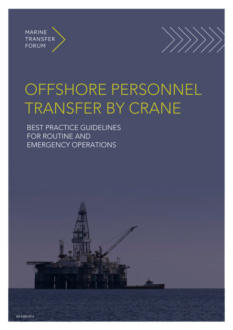


Publisher: Oil Companies International Marine Forum
This document, published by the "Oil Companies
International Marine Forum (OCIMF)", an association of
oil companies interested in the shipment of crude oil and
oil products, provides guidelines for transferring
personnel by crane between offshore vessels and
offshore platforms.

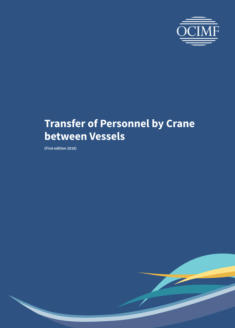
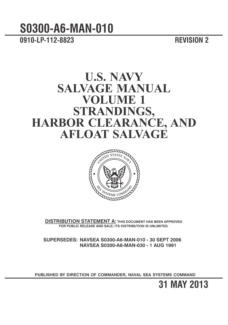



The purpose of the National Oceanic and Atmospheric
Administration (NOAA) Diving Program (NDP) Diving
Medical Standards and Procedures Manual is to provide
uniform criteria and interpretation of physical qualification
for diving duties based on standards from current dive
medicine practice within a variety of government and
civilian organizations, as well as experts in dive medicine.


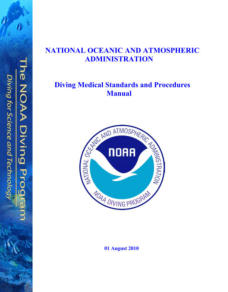

Click on the
octopus to return to
the top of the page



Authors
N. Crasta, D. Moreno-Salinas, M. Bayat, A. M. Pascoal, J.
Aranda
This document addresses the challenge of positioning
marine vehicles using range measurements in the
presence of unknown but constant ocean currents. Its
main contribution is the development of vehicle
trajectories that maximize the determinant of a Fisher
information matrix (FIM), ensuring collision avoidance and
maneuvering constraints. A numerical solution is
proposed for scenarios involving multiple vehicles and
beacons, while analytical solutions are provided for a
single vehicle and a static beacon.





This New Zealand health and safety at work bulletin
provides guidance about bounce diving during
occupational diving operations. It has been developed in
consultation with the New Zealand Diving Industry
Advisory Group (DIAG).

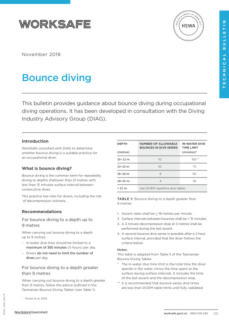
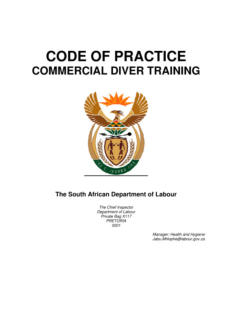

According to doctor Stanisław Skrzynski who provided
them, these tables utilize an original trimix method with
step decompression featuring a consistent 2m
depressurization gradient from the saturation plateau to
the surface. The procedures cover saturation plateaus
from 10-300m for trimix and 6-40m for nitrox, with
oxygen partial pressures at different depths. Trimix
compositions vary based on depth, with specific oxygen
and nitrogen percentages.
It seems that these tables are still in use in the Russian
Federation.


5 - Union of Soviet Socialist Republics (USSR) Saturation Diving tables
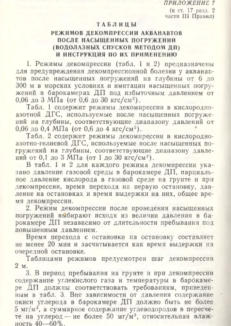

This guide looks at the Work in Compressed Air
Regulations 1996 and addresses such issues as safe
systems of work, medical surveillance, compression and
decompression procedures, medical treatment,
emergency procedures, fire precautions and instructions
and training.


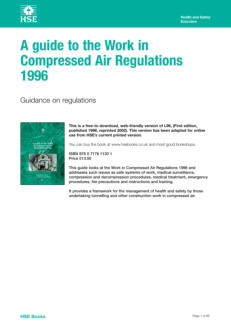
8 - UK HSE - A guide to the Work in Compressed Air Regulations
1996 & 2002

The Departmental Diving Safety Procedures of Fisheries
and Oceans Canada (DFO) are part of their Diving Safety
Program. This program ensures safe diving practices for
research and exploration in Canada's aquatic
environments. It adheres to the Canada Labour Code
and Canadian Occupational Safety and Health
Regulations on Diving Operations..



16 - Canadian department of safety procedures - Underwater diving
program

This document, provided by Doctor Stanisław Skrzynski
(Polish Naval Academy) and published in December
2002, describes the Russian Federation's deep sea diving.
This document is written in Russian. However, translation
is possible using specialized software.


17 - Ministry of defense of the Russian Federation - Organization of
deep sea diving


These regulations cover various aspects of commercial
diving, including safety protocols, equipment
requirements, and operational procedures to ensure the
well-being of divers. This document is the one that takes
the US Navy tables as the reference table in the United
States of America


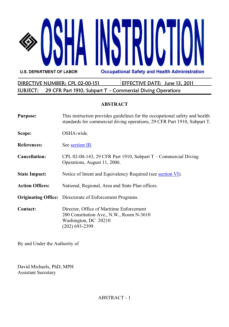
32 - OSHA - 29 CFR Part 1910, Subpart T – Commercial Diving
Operations

In 2014, Korea’s Ministry of Employment and Labor
Notification No. 2014-28 introduced decompression
tables for caisson and tunneling work, which, according
to the specialists who compared them with other well-
known tables, prioritized shorter decompression times
but lacked safety provisions.


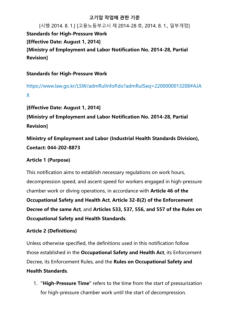
42 - Korean decompression tables for High-Pressure Work in caisson
and tunneling 2014 (Ministry of Employment and Labor
Notification No. 2014-28, Partial Revision)

This preliminary Regulatory Analysis (RA) assesses the
impacts of the proposed Commercial Diving Operations
Notice of Proposed Rulemaking (NPRM) by the Coast
Guard (USCG). The NPRM aims to update regulations for
commercial diving to enhance safety and clarity. The
commercial diving industry includes operations offshore
and within three miles from the coast. The proposed
updates implement safety standards aligned with the
Association of Diving Contractors International's latest
protocols.


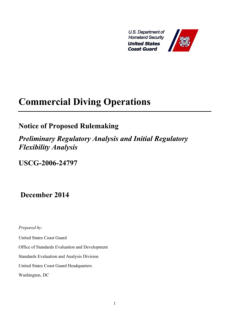
45 - US dept of Homeland Security - Commercial Diving Operations
- USCG-2006-24797

The following standards and procedures were
established by the NOAA Diving Program to provide
criteria, specifications, and requirements for operating
NOAA hyperbaric chambers. These standards and
procedures were developed to provide NOAA personnel
with information to outfit, man, and operate hyperbaric
chambers safely and effectively in support of NOAA
diving operations.


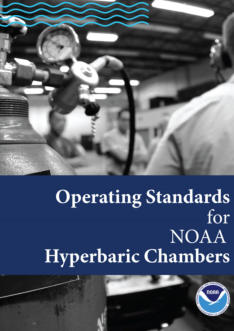
55 - Operating Standards for NOAA Hyperbaric Chambers

The Health and Safety at Work etc. Act 1974 was a
significant piece of legislation that provided a framework
for ensuring the health and safety of all employees in the
UK. This act laid the groundwork for more specific
regulations, including those for diving.


2 - UK health and Safety at work act 1974
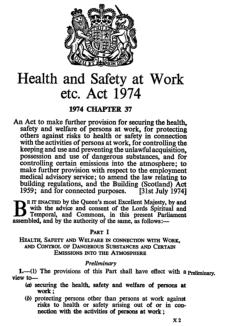

The Offshore Safety Act 1992 plays a crucial role in
ensuring the safety and health of workers on offshore
installations in the UK. It has evolved over time to address
new challenges and maintain high safety standards in
the offshore oil and gas industry.
Its creation is linked to the Piper Alpha disaster in 1986.


4 - UK Offshore Safety Act 1992
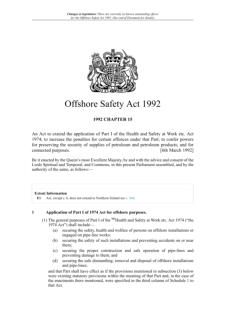

The Diving at Work Regulations 1997 in the UK were
introduced to enhance the safety and health standards
for professional divers, and have been periodically
reviewed and updated to reflect advances in diving
technology and safety practices.
They also serve as a model for diving safety regulations in
other countries and, therefore, have contributed to the
overall improvement of diving safety worldwide.


9 - UK- Diving at work regulations 1997
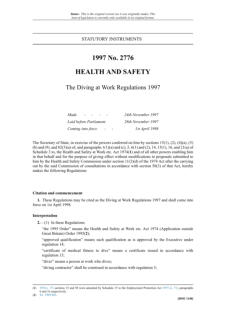
The "Code" on Health and Safety Protection of
Employees in the Workplace in Italy, known as Legislative
Decree 81/2008 or Testo Unico Sicurezza Lavoro (TUSL),
is a comprehensive legal framework that regulates health
and safety in the workplace. It represents a significant
effort by the Italian government to improve workplace
safety and protect the health and well-being of
employees across various sectors.


23 - Italy: The “Code” On Health And Safety Protection Of
Employees In The Workplace (Legislative Decree 81/2008)
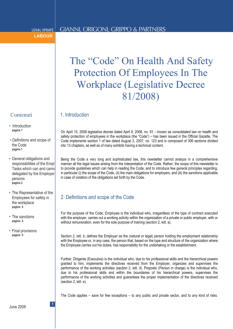

The Bellotti A.C. 344 bill aims to comprehensively regulate
underwater and hyperbaric activities, establishing the
relevant basic regulations and identifying the obligations
for operators and companies


26 - Italy: Disciplina delle attività subacquee e iperbariche
(Regulation of underwater and hyperbaric activities)
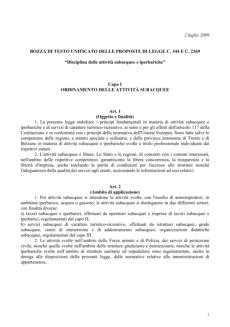

This document, provided by Doctor Stanisław Skrzynski
(Polish Naval Academy) and published in December
2002, describes the Russian Federation's deep sea diving.
This document is written in Russian. However, translation
is possible using specialized software.


29 - Italy: Health and Safety in diving and Hyperbaric professional
activities - Operational procedures - Italian version
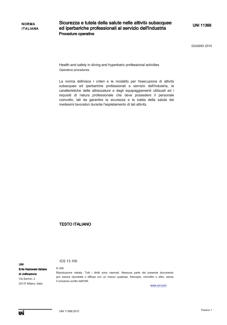

The "Unfallverhütungsvorschrift Taucherarbeiten"
(Accident Prevention Regulation for Diving Work) in
Germany is a set of regulations designed to ensure the
safety and health of professional divers. These
regulations are established by the German Social
Accident Insurance (Deutsche Gesetzliche
Unfallversicherung, DGUV) and outline the necessary
precautions and procedures to prevent accidents and
injuries during diving operations in German waters.


33 - Germany: Unfallverhütungsvorschrift Taucherarbeiten
(Accident prevention regulation - Diving work)
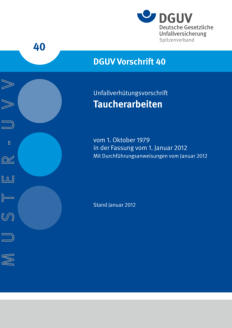

This Working Conditions Decree
(Arbeidsomstandighedenbesluit) is a set of regulations
that outlines the specific requirements for ensuring safe
and healthy working conditions. This decree is part of
the broader framework of the Working Conditions Act
(Arbeidsomstandighedenwet), which aims to protect the
health, safety, and welfare of employees in the
workplace. Its foundation was laid in the late 19th and
early 20th centuries with the introduction of early labor
laws that aimed to address poor working conditions and
protect workers' rights during the Industrial Revolution.


47 - The Netherlands: Working conditions decree (English,
uncontrolled version)
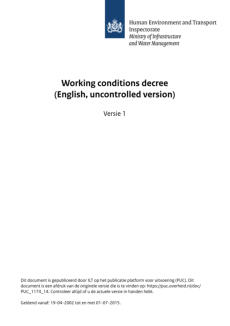

The primary purpose of this decree is to establish
standardized training procedures to ensure that all
workers exposed to hyperbaric risks are adequately
prepared and knowledgeable about the potential
hazards and safety protocols. It is an evolution of the
previous decrees, which were first published in 1974.


54 - France: Arrêté du 12 décembre 2016 définissant les modalités
de formation à la sécurité des travailleurs exposés au risque
hyperbare (Decree of December 12, 2016 defining the training
requirements for workers exposed to hyperbaric risk)
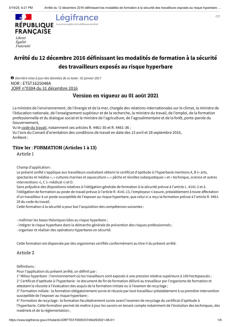

The Factories (Diving at Work) Regulations, 2018 in
Nigeria provide a legal framework to regulate diving
operations carried out offshore, inshore, and onshore
within the territorial waters of Nigeria. It reflects the
country's efforts to improve safety and operational
standards in the diving industry.


60 - Nigeria: Factories (Diving at work) regulations 2018
